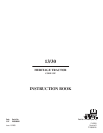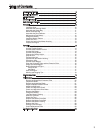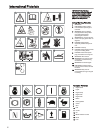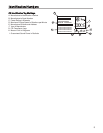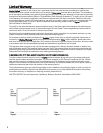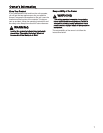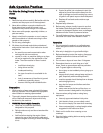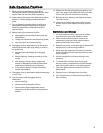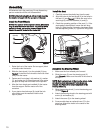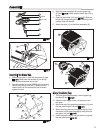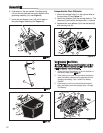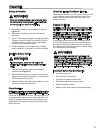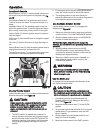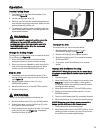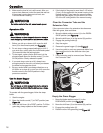
9
Safe Operation Practices
9. When using any attachments, never direct
discharge of material toward bystanders nor allow
anyone near the machine while in operation.
10. Never operate the mower with defective guards or
shields, or without safety protective devices in
place.
11. Do not change the engine governor settings or
overspeed the engine. Operating an engine at
excessive speed may increase the hazard of
personal injury.
12. Before leaving the operator’s position
a. disengage the power take-off and lower the
attachments;
b. change into neutral and set the parking brake;
c. stop the engine and remove the key.
13. Disengage drive to attachments, stop the engine,
and disconnect the spark plug wire(s) or remove
the ignition key
a. before cleaning blockages or unclogging
chute;
b. before checking, cleaning or working on the
mower;
c. after striking a foreign object. Inspect the
mower for damage and make repairs before
restarting and operating the equipment;
d. if the machine starts to vibrate abnormally
(check immediately).
14. Disengage drive to attachments when transporting
or not in use.
15. Stop the engine and disengage drive to
attachment
a. before refuelling;
b. before removing the grass catcher;
c. before making height adjustment unless
adjustment can be made from the operator’s
position.
16. Reduce the throttle setting during engine run-out
and, if the engine is provided with a shut-off valve,
turn the fuel off at the conclusion of mowing.
17. Before and when backing, look behind and down
for small children.
18. Use extra care when approaching blind corners,
shrubs, trees or other objects that may obscure
vision.
Maintenance and Storage
1. On multi-blade machines, take care as rotating
one blade can cause other blades to rotate.
2. When machine will be parked, stored or left
unattended, lower the cutting means unless a
positive mechanical lock is used.
3. Keep all nuts, bolts, and screws tight to be sure the
equipment is in safe working condition.
4. Never store the equipment with petrol in the tank
inside a building where fumes may reach an open
flame or spark.
5. Allow the engine to cool before storing in any
enclosure.
6. To reduce the fire hazard, keep the engine,
silencer, battery compartment and petrol storage
area free of grass, leaves, or excessive grease.
7. Check the grass catcher frequently for wear or
deterioration.
8. Replace worn or damaged parts for safety.
9. If the fuel tank has to be drained, this should be
done outdoors.



